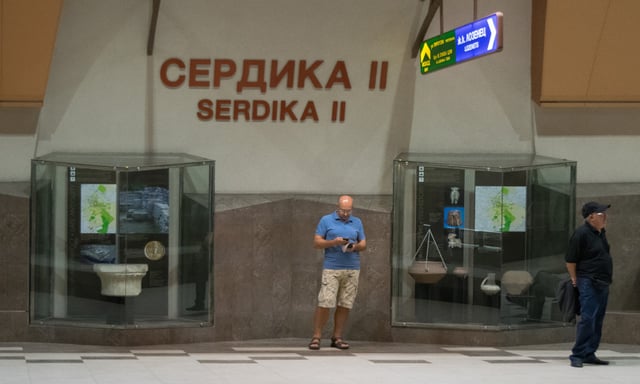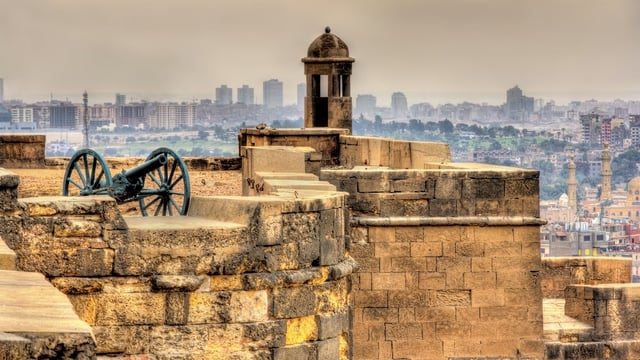Instead of billboards on the platform, passengers arriving at Sofia’s Serdika II Metro station are greeted with stylish glass cases displaying some of the city’s finest prehistoric and ancient artefacts. Complete Neolithic pots and well preserved capitals of Classical columns are amongst a few of the objects used to tell the histories of Sofia’s past. Taking the escalators up to street level commuters and visitors emerge through the restored streets of Roman Sofia, or Serdica; from which the metro station takes its name. Definitely and archaeological highlight of my trip to Sofia.
- Thomas Dowson
- Last Checked and/or Updated 11 February 2022
- No Comments
- Bulgaria
Digging out Metro tunnels and stations in many European cities often results in the discovery of interesting and ancient archaeology. In some cities these discoveries hardly come as much of a surprise. After all, many have had continuous habitation that stretches back a couple of thousand years. Excavations for some of the central metro stations in Athens produced spectacular finds. What’s more, these stations and even the platforms provide superb opportunities for the in situ and near-in situ display of archaeological artefacts recovered and features exposed. In Paris, for example, foundations of the notorious 14th century Bastille fortress can be seen on the platform of the Bastille Métro.
One of the latest European cities open its metro archaeology in 2016 is the Bulgarian capital Sofia. Although the wider area has evidence for human occupation dating back to at least the Neolithic, the centre of the city is widely believed to have been a settlement called Serdica or Sardica, inhabited by the Serdi Thracian tribe. After a brief spell under the control of Philip of Macedon and his son Alexander the Great in the 4th century BC, the city was conquered by the Romans in about 29 BC and renamed Ulpia Serdica. In 45 AD it became an administrative centre in the Roman Province of Thrace, and under Emperor Trajan it became a self governing centre, referred to officially as “The most brilliant city of the Serdi.” Over the following six centuries the city flourished, and Constantine the Great is said to have called Serdica “my Rome”.
The archaeology of these first six centuries is what makes up the Archaeological Complex ‘Serdica’; ruins of Sofia’s Roman past that were discovered between 2010 and 2012 during excavations for a metro line. While the presence of archaeology was not a surprise (the exposed East Gate, nearby in the underpass between the Ministry Council and the Presidency have been known about for some time), the remarkable preservation of structures uncovered was. The archaeological research here was carried out by two teams of archaeologists from the National Archaeological Institute with Museum and the Sofia History Museum.
A Platform for Presentation




Getting off the train at the Serdika II station, whether heading north or south, you can not miss the series of glass-cased displays. They do not seem to be arranged in any order, but collectively they tell the story of Sofia’s past from the Neolithic to the construction of the metro station. With an excellent set of maps and informative labels in both Bulgarian and English, these exhibits give a good introduction to the archaeology of Sofia.
If you are not travelling by metro but are looking at the Roman ruins outside the station, I highly recommend taking some time to go down to the platforms. You can buy a ticket for only лв1.60 – that is one lev, 60 stotinki. The cheapest museum ticket in Sofia, if not Bulgaria!
Archaeology in the Station

The most visible feature in the station’s north ticketing foyer is the curved apse of an early Christian basilica (photograph above). Built towards the end of the 4th century AD, it was probably destroyed in the mid 5th century during invasions by the Huns. All signs indicate the church was probably not rebuilt.
To the right of the apse the floor has glass panels allowing you to look on to an extraordinarily rare find; the vine and wooden walls of a 1st century Roman dwelling (photograph below). The wall was made up of oak and beech beams, that were inter-laced with vine twigs – all clearly visible to us today. The wood and vines would have been covered with a mixture of clay and fine stones – this has not survived.
Another interesting feature, also rarely so well preserved, are the remains of wooden pallets that were placed beneath walls to give the walls added stability (photograph below). Now all we can see are the pointed and charred remains of the wood, burned like by fire when the buildings were destroyed by the Huns.


Archaeological Complex ‘Serdica’
The Roman remains of Serdica were found during the construction of the metro station. During 2010 and 2012 two teams of archaeologists from the National Institute of Archaeology with Museum at the Bulgarian Academy of Sciences and Municipal Cultural Institute Museum for the History of Sofia excavated this section of ancient Serdica. The features excavated covered an area of eight streets of the ancient city, and include a Christian Basilica, six large buildings with mosaic floors, courtyards, baths, public toilets and their associated water supply and sewage systems. Most of the visible remains date between the 4th to 6th centuries, but in various localities these are on top of structures that are as old as the 1st century.




Controversies & Critics
As with most infrastructure projects, certainly it seems those that involve European Union funding, the restoration of the Roman ruins at the Serdika Metro station is not without controversies. There were the all too familiar delays and over-runs, alarming criticisms of construction workers damaging archaeological features, and even a public outcry over restoration techniques brought a temporary halt to the project in October 2015.

So it was probably with a great sense of relief that the Bulgarian Prime Minister Boyko Borisov and Culture Minister Vezhdi Rashidov were eventually able to open the in situ, open-air site in April 2016.
Not wishing to downplay or dismiss the genuine concerns associated with this project, I think the presentation of the Roman remains at the Serdika II Metro station is an excellent addition to the cityscape. Far too often important archaeological sites are covered over by contemporary constructions around the world, and any attempt to incorporate ancient remains into our towns and cities today should be encouraged and applauded. Of course, not at any cost. Perhaps I am a tad sceptical of the tendency in EU-funded projects to waste money, I admit to wondering where the eight million plus Euros were spent. But I can not get excited over the criticisms of the restoration works – which some have likened to Lego. Perhaps I am just showing my age, but I really have heard it all before. A few decades ago I probably even hurled such accusations. One thing I have learned, all restoration projects have their ‘problems’.
Here in the heart of present-day Sofia locals and visitors can see the remains of an ancient street from the city of Serdica. And these remains rival those in any other major European city. The Serdika II Metro station is in effect a gateway, not only to many other fascinating sites in the Bulgarian capital, but also to many thousands of spectacular sites throughout the country. The real scandal will come if the 250 million Euros invested in developing Bulgaria’s cultural attractions (from 2013 until at least 2020) are not part of a proactive strategy by tourist authorities to attract visitors.
For me, the Serdika II Metro Station is an interesting and impressive point from which to explore Sofia’s past. After a good introduction on the platform, walk out of the steel and glass of the station and onto the flagstones of a Roman street.

From the ruins at the station head south to the adjacent Ploshtad Nezavisimost (Independence Square), which is between the Bulgarian government’s Council Ministry building and the Presidency. Here you will find further remains from ancient Serdica to see, including the East Gate of the first walls built to protect Serdica, constructed in the later 2nd century AD. And don’t forget to look into the Courtyard behind the Presidency, to see the intact early Christian Church of St George – Sofia’s oldest building.






